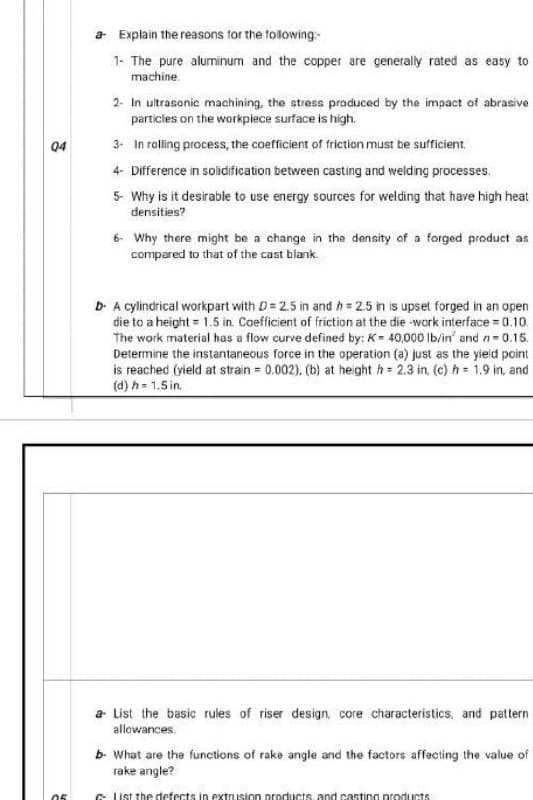1- The pure aluminum and the copper are generally rated as easy to machine 2- In ultrasonic machining, the stress produced by the impact of abrasive particles on the workpiece surface is high. 3- In rolling process, the coefficient of friction must be sufficient.
1- The pure aluminum and the copper are generally rated as easy to machine 2- In ultrasonic machining, the stress produced by the impact of abrasive particles on the workpiece surface is high. 3- In rolling process, the coefficient of friction must be sufficient.
Elements Of Electromagnetics
7th Edition
ISBN:9780190698614
Author:Sadiku, Matthew N. O.
Publisher:Sadiku, Matthew N. O.
ChapterMA: Math Assessment
Section: Chapter Questions
Problem 1.1MA
Related questions
Question

Transcribed Image Text:04
05
a Explain the reasons for the following:
1- The pure aluminum and the copper are generally rated as easy to
machine
2- In ultrasonic machining, the stress produced by the impact of abrasive
particles on the workpiece surface is high.
3- In rolling process, the coefficient of friction must be sufficient.
4- Difference in solidification between casting and welding processes.
5- Why is it desirable to use energy sources for welding that have high heat
densities?
6- Why there might be a change in the density of a forged product as
compared to that of the cast blank.
D. A cylindrical workpart with D=2.5 in and h=2.5 in is upset forged in an open
die to a height = 1.5 in. Coefficient of friction at the die -work interface = 0.10
The work material has a flow curve defined by: K= 40,000 lb/in' and n-0.15.
Determine the instantaneous force in the operation (a) just as the yield point
is reached (yield at strain = 0.002), (b) at height = 2.3 in. (c) h= 1.9 in, and
(d) h = 1.5 in.
a List the basic rules of riser design, core characteristics, and pattern
allowances.
b- What are the functions of rake angle and the factors affecting the value of
rake angle?
Glist the defects in extrusion products, and casting products.
Expert Solution
This question has been solved!
Explore an expertly crafted, step-by-step solution for a thorough understanding of key concepts.
This is a popular solution!
Trending now
This is a popular solution!
Step by step
Solved in 2 steps with 1 images

Knowledge Booster
Learn more about
Need a deep-dive on the concept behind this application? Look no further. Learn more about this topic, mechanical-engineering and related others by exploring similar questions and additional content below.Recommended textbooks for you

Elements Of Electromagnetics
Mechanical Engineering
ISBN:
9780190698614
Author:
Sadiku, Matthew N. O.
Publisher:
Oxford University Press

Mechanics of Materials (10th Edition)
Mechanical Engineering
ISBN:
9780134319650
Author:
Russell C. Hibbeler
Publisher:
PEARSON

Thermodynamics: An Engineering Approach
Mechanical Engineering
ISBN:
9781259822674
Author:
Yunus A. Cengel Dr., Michael A. Boles
Publisher:
McGraw-Hill Education

Elements Of Electromagnetics
Mechanical Engineering
ISBN:
9780190698614
Author:
Sadiku, Matthew N. O.
Publisher:
Oxford University Press

Mechanics of Materials (10th Edition)
Mechanical Engineering
ISBN:
9780134319650
Author:
Russell C. Hibbeler
Publisher:
PEARSON

Thermodynamics: An Engineering Approach
Mechanical Engineering
ISBN:
9781259822674
Author:
Yunus A. Cengel Dr., Michael A. Boles
Publisher:
McGraw-Hill Education

Control Systems Engineering
Mechanical Engineering
ISBN:
9781118170519
Author:
Norman S. Nise
Publisher:
WILEY

Mechanics of Materials (MindTap Course List)
Mechanical Engineering
ISBN:
9781337093347
Author:
Barry J. Goodno, James M. Gere
Publisher:
Cengage Learning

Engineering Mechanics: Statics
Mechanical Engineering
ISBN:
9781118807330
Author:
James L. Meriam, L. G. Kraige, J. N. Bolton
Publisher:
WILEY